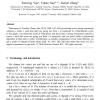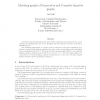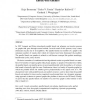108
click to vote
SIAMCOMP
2010
14 years 7 months ago
2010
We show that Edge Dominating Set, Hamiltonian Cycle, and Graph Coloring are W[1]-hard parameterized by clique-width. It was an open problem, explicitly mentioned in several papers,...
105
click to vote
GC
2010
Springer
14 years 9 months ago
2010
Springer
A graph of order n is said to be pancyclic if it contains cycles of all lengths from three to n. Let G be a hamiltonian graph and let x and y be vertices of G that are consecutive ...
IPL
2002
15 years 3 days ago
2002
This paper deals with the problem of constructing a Hamiltonian cycle of optimal weight, called TSP. We show that TSP is 2/3-differential approximable and can not be differential a...
104
Voted
DAM
2000
15 years 7 days ago
2000
Thomassen (J. Combin. Theory Ser. B 28, 1980, 142
90
Voted
ARSCOM
2004
15 years 9 days ago
2004
We show that in any graph G on n vertices with d(x) + d(y) n for any two nonadjacent vertices x and y, we can fix the order of k vertices on a given cycle and find a hamiltonian c...
101
Voted
JGT
2007
15 years 9 days ago
2007
A graph is uniquely hamiltonian if it contains exactly one hamiltonian cycle. In this note we prove that there are no r-regular uniquely hamiltonian graphs when r > 22. This im...
JGAA
2007
15 years 9 days ago
2007
We show how to find a Hamiltonian cycle in a graph of degree at most three with n vertices, in time O(2n/3
ENDM
2007
15 years 12 days ago
2007
Kreweras’ conjecture [9] asserts that every perfect matching of the hypercube Qd can be extended to a Hamiltonian cycle of Qd. We [5] proved this conjecture but here we present ...
104
click to vote
DAM
2007
15 years 12 days ago
2007
In 1997 Lampert and Slater introduced parallel knock-out schemes, an iterative process on graphs that goes through several rounds. In each round of this process, every vertex elim...
95
Voted
DM
2008
15 years 15 days ago
2008
A simple graph G is k-ordered (respectively, k-ordered hamiltonian) if, for any sequence of k distinct vertices v1, . . . , vk of G, there exists a cycle (respectively, a hamilton...





